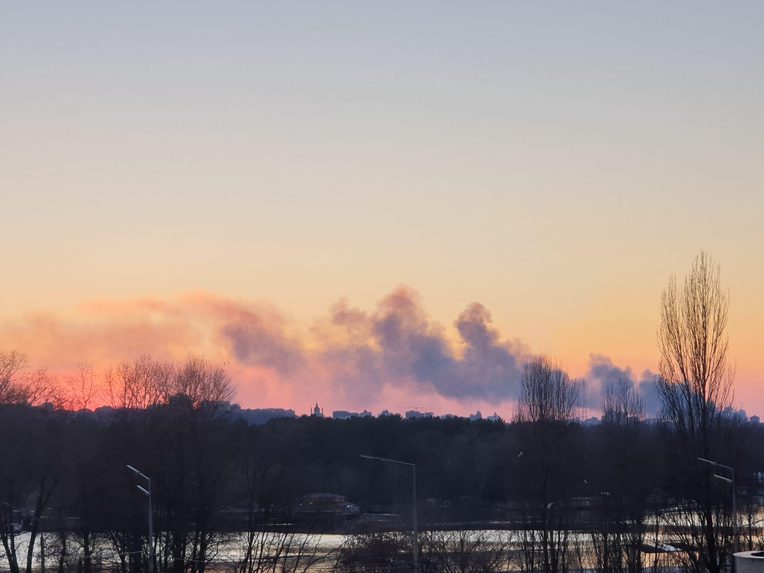Gravitas: A Sense of War in Five Words
From the Series: Russia’s War in Ukraine, Continued
From the Series: Russia’s War in Ukraine, Continued

The attack on Ukraine that opened February 24 like a shrapnel wound has torn apart the routines and narratives of daily life. For many, the present has been physically displaced into the makeshift bomb shelter, the emotional shelter of a friend’s couch, or across borders with the largest flight of refugees ever recorded. Formerly rarely used words crowd the days, specialized vocabulary pressed into daily service: nouns like “air-raid siren” or DRG (Russian acronym for “diversionary and sabotage groups”—as in, “my uncle called from the village and said they nabbed a DRG trying to blow up the regional water pumping station”), verbs like “to take shelter” or “to desert and melt in with the local population.” Even familiar verbs, like that in a video my friend sent of someone yelling at him—“Run! [biZHIIIIIIIt!]”—take on new imperative force when the exclamation mark is the whistle of an artillery shell.
This militarization of everyday life reverberates with the disorienting force of a massive invasion that, in advance, most people did not believe would happen. The vivid nouns and verbs of armed conflict are strung together by the seemingly unperturbed, prosaic workhorse parts of speech, which, though apparently less dramatic, are working overtime to patch up frames of reference. After all, context has taken a direct hit. To try to understand the forms that disorientation is taking, I consider deictics, that category of words in any language that depend wholly on context for meaning. (Examples in English include pronouns like “me” and “you” or adverbs like “here” and “there.”) In this essay, I trace five deictic adverbs to follow how Ukrainians are making sense of a present that makes no sense.
From Tam to Potim: In the mental geography of the Cold War, Europe used to be tam, “over there.” By the early 2000s, after a decade of independence, the term took a Whorfian turn and for post-Soviet Ukrainians, “Europe” had also come to signify a time, potim—that is, “then,” where Ukraine was headed, a way of conceptualizing the future (Eppinger 2009). In 2014, when their president announced a U-turn on integration into the European Union, hundreds of thousands Ukrainians took to the streets to protest: more than a policy change, the sense was that he had disappeared the future. The Euromaidan movement placed itself by reference simultaneously in Kyiv’s central Maidan square in the present and in that future called “Europe.” Of course, leaving Europe as potim, “then,” left much to be defined and discovered, including what kind of grounding might lay within Europe for Ukrainians.
. . . to Kudi?: Contours of that ground have become immediately more familiar for the estimated 3.5 million people who have fled Ukraine to an EU member-state in the first four weeks of the war. The unprecedented mass exodus has led to a new dominating adverb, kudi: “To where?” Since the war began, potim is overshadowed by kudi in regard to “Europe.” Messages exchanged with dozens of friends over the last four weeks could be boiled down to that one question: Kudi? Where are you running to? Where would you hide if you needed to take cover? On what mode of transport would you evacuate, where would it head, and could you even get to a train or bus depot if needed? Many of those conversations are still in the subjunctive, at least for now; most Ukrainians have not (yet) headed off. Half of Kyiv, an estimated 2 million people, is “sheltering in place.” When I began this essay, three weeks into the war, only a miniscule fraction of the total population of Mariupol—300,000 people whose city is being leveled around them by aerial bombardment as I write—had managed to find an unassailed evacuation route. For them, the answer to kudi is vniz, “downward”: below ground, or huddled. Food stocks have run out. The municipal water system has been bombed out of existence and the mayor reports citizens risking shelling to drink from puddles in the street. The question that hovers for survivors is kudi.
. . . Amid the “Here and Now,” Tut and Zaraz: On March 3, a woman in a bomb shelter in Kyiv, Marta Smekhova, recorded and uploaded a video that flew through Ukrainian social media and beyond: a little girl trying to raise morale by singing a theme song from the Disney musical Frozen. In English, the words urge, “Let it go! Let it go!” The girl in the video, Amelia Anysovych, belts out the Russian version, demanding “Otpusti! I zabud’! Chto proshlo uzhe ne vernut [Let it go! And forget! What has passed will not return!]!” The same sentiment resonated in thousands of conversations from which the topic of daily life before the war has disappeared. The word todi, meaning “then” in the retrospective sense, has made itself scarce since the war started, crowded out by zaraz, “now,” and tut, “here.” Videos tweeted out from President Zelensky harness this sensibility. In one viral clip made to rebut rumors that he had fled the country, Zelensky live-streamed himself with a few close advisors from the center of Kyiv, pointing at each person in turn and repeating, X—tut (X is here), Y—tut (Y is here), Ya—tut (I am here), etc. As with young Amelia, instead of todi, the focus is on zaraz, right now. And instead of tam, over there, the focus is on tut, right here.
Though tut and zaraz, “here” and “now,” seem to hinge on immediacy, matters are not always that straightforward. Distortions with the “here-and-now” intervene. One friend reports he has started hearing air raid sirens even when they are not going off. Another, Olga Klymenko, writing of a village retaken by Ukrainian forces, says:
"Makariv is ours after a few days’ fighting.
But there isn’t much Makariv left.
At some point your brain becomes numb to comprehension of the scale of the destruction."
I once likened post-Soviet Ukraine to conditions of zero gravity (Eppinger 2014). Now, amid compressed scenes of utter devastation and a sense of immanence so powerful that it feels hallucinatory at times, new fields of gravity are exerting themselves. Tut, “here,” becomes a heavy place and zaraz, “now,” is a time that overwhelms the capacity to take it in.
Potim, that sense of “then-in-the-future,” has also taken on new valences. Despite a war ostensibly over Kremlin concerns about the Europeanization of Ukraine, potim has lost some of the elision between Europe and the future that used to be so common. In spite of the overwhelming immanence of the here and now, potim is still holding its own. Sofya Dyak, a historian, is still occupied with todi, the “back then” of her studies of 1939 Lviv, a city on the brink of World War II. But these days, even the historian is reorienting forward. When asked about the demands of the present, she answers: “We need to start thinking about how we are going to write the history of this war in the future.” Dyak’s response aligns historians’ orientation with that of anthropologists, as it contains implicit questions that unite the now, zaraz, and the then-in-the-future, potim: What kind of historians then (potim) do we want to be? Deictics hang in that context like question marks without a sentence. The present may be hardening but the future is as open as a shrapnel wound. Where, how, and who will we be?

Eppinger, Monica E. 2009. “Nation-Building in the Penumbra: Notes from a Liminal State.” Hastings International and Comparative Law Review 32 (2): 773–94.
Eppinger, Monica E. 2014. “On Common Sense: Lessons on Starting Over from Post-Soviet Ukraine.” In Studying Up, Down, and Sideways: Anthropologists Trace the Pathways of Power, edited by Rachael Stryker and Roberto Gonzalez, 192–210. London: Berghahn Books.